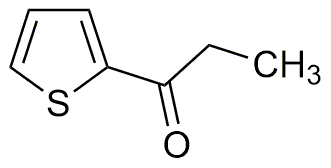2-Propionylthiophene is widely utilized in research focused on:
- Flavor and Fragrance Industry: This compound is used to create unique aromas in perfumes and food products, enhancing sensory experiences.
- Organic Synthesis: It serves as a valuable intermediate in the synthesis of various organic compounds, making it essential for chemists developing new materials.
- Pharmaceuticals: Its derivatives are explored for potential therapeutic applications, particularly in developing novel drugs with specific biological activities.
- Polymer Chemistry: 2-Propionylthiophene can be utilized in creating specialty polymers, contributing to advancements in materials science.
- Research on Conductive Materials: This compound is investigated for its role in developing conductive organic materials, which are crucial for electronic applications.
General Information
Properties
Safety and Regulations
Applications
2-Propionylthiophene is widely utilized in research focused on:
- Flavor and Fragrance Industry: This compound is used to create unique aromas in perfumes and food products, enhancing sensory experiences.
- Organic Synthesis: It serves as a valuable intermediate in the synthesis of various organic compounds, making it essential for chemists developing new materials.
- Pharmaceuticals: Its derivatives are explored for potential therapeutic applications, particularly in developing novel drugs with specific biological activities.
- Polymer Chemistry: 2-Propionylthiophene can be utilized in creating specialty polymers, contributing to advancements in materials science.
- Research on Conductive Materials: This compound is investigated for its role in developing conductive organic materials, which are crucial for electronic applications.
Documents
Safety Data Sheets (SDS)
The SDS provides comprehensive safety information on handling, storage, and disposal of the product.
Product Specification (PS)
The PS provides a comprehensive breakdown of the product’s properties, including chemical composition, physical state, purity, and storage requirements. It also details acceptable quality ranges and the product's intended applications.
Certificates of Analysis (COA)
Search for Certificates of Analysis (COA) by entering the products Lot Number. Lot and Batch Numbers can be found on a product’s label following the words ‘Lot’ or ‘Batch’.
*Catalog Number
*Lot Number
Certificates Of Origin (COO)
This COO confirms the country where the product was manufactured, and also details the materials and components used in it and whether it is derived from natural, synthetic, or other specific sources. This certificate may be required for customs, trade, and regulatory compliance.
*Catalog Number
*Lot Number
Safety Data Sheets (SDS)
The SDS provides comprehensive safety information on handling, storage, and disposal of the product.
DownloadProduct Specification (PS)
The PS provides a comprehensive breakdown of the product’s properties, including chemical composition, physical state, purity, and storage requirements. It also details acceptable quality ranges and the product's intended applications.
DownloadCertificates of Analysis (COA)
Search for Certificates of Analysis (COA) by entering the products Lot Number. Lot and Batch Numbers can be found on a product’s label following the words ‘Lot’ or ‘Batch’.
*Catalog Number
*Lot Number
Certificates Of Origin (COO)
This COO confirms the country where the product was manufactured, and also details the materials and components used in it and whether it is derived from natural, synthetic, or other specific sources. This certificate may be required for customs, trade, and regulatory compliance.


